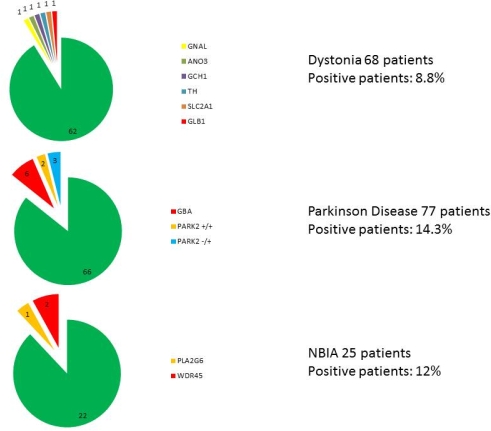Session Information
Date: Tuesday, June 21, 2016
Session Title: Genetics (NON-PD)
Session Time: 12:30pm-2:00pm
Location: Exhibit Hall located in Hall B, Level 2
Objective: To investigate the impact of movement disorder gene panels in clinical practice and the proportion of patients receiving a definite genetic diagnosis through Next Generation Sequencing (NGS) in a tertiary referral centre.
Background: Genetic biobanks are a powerful tool in basic, translational and clinical research in rare diseases. In the biobank of our institute, part of the Telethon Network of Genetic Biobank, a large number of DNAs from patients with movement disorders (MD) are available. The number of MD-associated genes has greatly increased recently thanks to the advances in molecular techniques; the use of NGS allowed us to simultaneously analyze a large number of these genes.
Methods: DNAs from 170 patients with genetically undiagnosed movement disorders were selected from our MD biobank and tested by targeted re-sequencing using customized gene panels including known genes associated with dystonia (19 genes), Parkinson’s disease (PD) (19) and Neurodegeneration with Brain Iron Accumulation (9)
| PD | Dystonia | NBIA |
| PINK1 | TOR1A | PANK2 |
| PARK2 | THAP1 | |
| LRRK2 | PRKRA | PLA2G6 |
| ATP13A2 | TAF1 | |
| PARK7 | TIMM8A | FTH1 |
| SNCA | GCH1 | |
| FBXO7 | TH | FTL |
| SYNJ1 | SGCE | |
| DNAJC6 | ATP1A3 | C19ORF12 |
| VPS35 | PNKD | |
| EIF4G1 | PRRT2 | WDR45 |
| DNAJC13 | SLC2A1 | |
| UCHL1 | CIZ1 | FA2H |
| GIGYF2 | ANO3 | |
| HTRA2 | GNAL | CoAsy |
| GBA | BCAP31 | |
| MAPT | NKX2-1 | CP |
| GRN | TOR1AIP1 | |
| ATP6AP2 | GLB1 |
Results: 77 patients recruited had PD (45%), 25 NBIA (15%) and 68 isolated or combined dystonia (40%). In 20/170 patients (11.7%) pathogenic variants in one of the genes analyzed were found, leading to a definite genetic diagnosis. Among them, 11 (55%) had PD, 3 (15%) NBIA and 6 (30%) dystonia. A positive family history was present in 7/20 mutated patients. Mutated genes in each MD category are shown in Figure 1.
Conclusions: Despite advanced diagnostic techniques and the availability of a large number of genetically undefined MD patients, the proportion (11.7%) of cases sorted in our series remains scarce. This may be due to either technique limitations (repeat expansions or large insertions and deletions are missed by NGS) or to a still limited knowledge of MD causative genes. Dedicated gene panels seem to have a limited impact in clinical practice, helping reaching a genetic diagnosis in a small number of cases.
To cite this abstract in AMA style:
C. Barzaghi, C. Panteghini, M. Carecchio, A. Legati, V. Monti, C. Reale, F. Invernizzi, B. Garavaglia. The relevance of movement disorders gene panels in clinical practice: How many patients are we sorting out? [abstract]. Mov Disord. 2016; 31 (suppl 2). https://www.mdsabstracts.org/abstract/the-relevance-of-movement-disorders-gene-panels-in-clinical-practice-how-many-patients-are-we-sorting-out/. Accessed December 7, 2025.« Back to 2016 International Congress
MDS Abstracts - https://www.mdsabstracts.org/abstract/the-relevance-of-movement-disorders-gene-panels-in-clinical-practice-how-many-patients-are-we-sorting-out/
